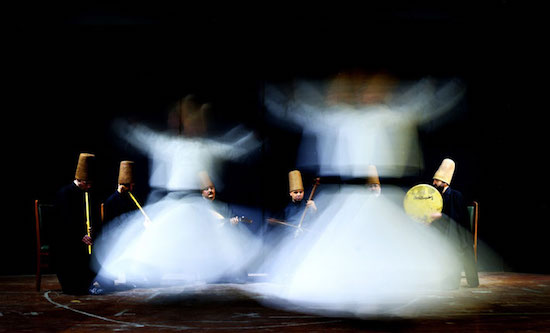In today’s Turkey, while political repression creeps ever more pervasively, the government’s stance on Sufi musical practices has rarely been softer. The Mevlevi sema (whirling dervish ceremony) is a profitable tourist attraction after all, purged of political influence since the secularist reforms of the 1920s. In Iran by contrast, while the medieval Sufi scholar Jalāl ad-Dīn Muhammad Rūmī is claimed as a national treasure, his love of music is not exactly shared by the state: most music was banned after 1979 for flouting the Islamic Republic’s strict doctrine. Parissa, the singer whose ribbons of vocalisation graced the second half of this evening, was herself "condemned to silence". And Rumi has yet another life in the West, as a ‘liberal’ Islamic (or even trans-religious) spiritualist, tolerant of alcohol and cultural difference.
It was Rumi who undergirded this challenging and revelatory slice of the Barbican’s Transcender series, with Ottoman and Persian settings of his texts occupying one half each of the evening. Things began, like Rumi’s great poem the ‘Masnavi’, with the ney (end-blown wooden flute). For Rumi, its wailing symbolises the lament of the soul drifting from its source. For those of us less inclined to spiritual analogies this taksim (preface) was no less captivating, delivered with patient elasticity by Muhammed Ceylan. But the centrepiece of this first UK appearance by Konya’s Meshk Ensemble is a performance of the sema, featuring a recently rediscovered set of pieces from the early 20th century. The ensemble navigated this soberly and formidably, articulating the tension between monophonic seyir – melodic contour – and durak – “resting place”. Director and vocalist Timucin Cevikoglu has a subtle but commanding presence, particularly in his low register.
As for the five semazen (turners) themselves, witnessing their ceremony proved a strange experience – both beautiful and uncomfortable. Once in motion the composite visual effect of the semazen clustered on stage drew us in undeniably. Tapered sikke caps, sleeves, faces and weightless skirting formed an undulating kaleidoscope, criss-crossed by hands – turned upwards (‘to heaven’) or downwards (‘to earth’). At the same time, to gaze on someone else’s ritual is always a potentially invasive act, and to do so in the Barbican Hall – to consume the sema as institutionalised spectacle – is to participate in a kind of orientalism. In a country whose political present is so fraught, can’t we do better than to fixate on its distant and scholastic past? During the 2013 demonstrations, for example, music was famously placed at the heart of Gezi Park’s new mode of protest known as “chapulling” (https://www.freewordcentre.com/explore/gezi-protest-songs). The diverse recordings assembled here (https://capulcular.bandcamp.com/album/apulcu-ark-lar) – from studio and street – are testament to the dynamic, disruptive possibilities of music in Erdogan’s Turkey.
Like Meshk Ensemble, Parissa – in her first London show in a decade and flanked by three instrumentalists – cleaved respectfully to tradition, in this case the classical Persian dastgah that has been her lifelong focus. But where the sombre pacing of the first half became increasingly demanding, this was music of extreme poise, that could turn on a sixpence from impossibly still to richly kinetic: an intimate, almost transformative hour of interplay.
Parissa’s story traverses the last, precarious half-century of music in Iran. She rose to prominence in the late 1960s as a student at the Ministry of Culture and Art, giving televised concerts and international tours. In the 1970s she often participated in the Shiraz Arts Festival, the programming for which also famously included an array of radical and avant-garde figures from Max Roach to Karlheinz Stockhausen. Then, following the return to power of the Ayatollah Khomeini in 1979, like other musicians she was silenced and barred from performing abroad. Though the authorities soon invited her to return to a teaching post, it was only fifteen years later – with the travel ban finally lifted – that she could perform again.
Whatever the impact of its history of confinement, Parissa’s voice is palpably expressive. At some moments her vocal flights were chased playfully around the dastgah-e mahoor modal system by Iman Vaziri’s tar (Persian lute); at others the skeletal figurations of Saeed Kamjoo’s bowed kamancheh rose up and thrashed above the intricate daf patterns of Dara Afraz. Sat in a traditional, static formation, the four nevertheless produced the most vivid sense of movement this pair of ears has heard all year.
Parissa has said that she “strongly believe[s], if a musician stays sincere in creating a mystical music, he or she can connect to a like-minded audience regardless of language barriers”. I can’t entirely share her universalism: it’s surely because – as much as regardless – of cultural barriers that Persian and Ottoman art musics move international audiences. These are intensely codified traditions that often confound the ‘outsider’, and while this quality might seem distant from the uplifting, “consciousness-expanding” remit of Transcender, in reality those challenges should be cherished.


